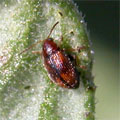USE OF PLANT GROWTH REGULATORS
Poor bud burst is a problem after winter pruning in many varieties, which can be improved by smearing 2% Hydrogen Cyanamide (H2CN2) to the terminal three buds on the canes with cotton swab. Two sprays of CCC at a concentration of 500 or 1000 ppm on the foliage is used to check the vigorous growth of canes during summer, so that bud fertility improves. Spraying of “URACIL” at 50 ppm at 35-40 days stage after back pruning can also be made to improve the bud fertility. Gibberellic acid (GA3) is used either as spray or dip right from 10 ppm for rachis elongation and flower thinning to 25-40 ppm for berry elongation at later stages. Use of other chemicals like Brassinolide (Combine), Benzyl Adenine (BA) and CPPU {1-(2-chloro-4-pyridyl)-3-phenylurea (IUPAC); N-(2-chloro-4-pyridinyl)-N'-phenylurea} are employed to get fruits of export quality. Schedule of plant growth regulator application is as follows:
|
No. of days after pruning |
Stage |
Purpose |
Chemical |
Concentration (ppm) |
|
28-30 |
Pre bloom |
Rachis elongation |
GA3 |
10 |
|
32-35* |
Full bloom |
Flower thinning |
GA3 |
20-25 |
This spray may be repeated to get optimum thinning or couple with heavy
irrigation which also encourages thinning. Spray of Carbaryl (0.2%) also
helps in thinning
** Combine contains Brasinnosteroid
in alcohol medium; hence GA3 can be mixed in it directly.*** The BA treatment can also be given in place of Combine to get the
desired size.
in coloured seedless varieties, cytokinin compound may be avoided in second sizing spray as it retains green colour for longer duration. In seeded variety like Red Globe GA3 is recommended at very lower concentration at pre-bloom state (5-10 ppm) and at 8-10 mm berry stage (10 pm) for increasing the berry size. Excess application of GA3 in seeded varieties may cause coiling of rachis and tends to become woody and brittle.


